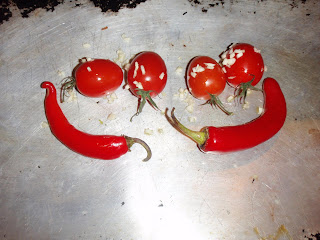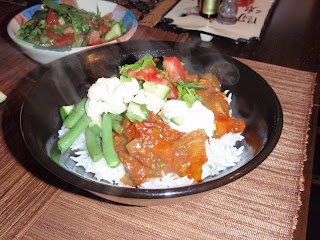Slow-Roasted Greek Lamb (w Roasted root vegetables)
 Ingredients:
Ingredients:Lamb:
1.2kg leg of lamb cut into sizeable chunks
3 cloves garlic quartered
2 tbsp fresh rosemary
1 tbsp thyme
homemade stock from stubs vegetables and lamb bones
2 tbsp lemon juice
Stock: lamb lower leg bone, bay leaves, vegeta stock cube, extra vegetables.
Root Vegetables:1 potato, sliced in chip wedges
1 parsnip halved lengthways
1 small sweet potato scrubbed but skin left on, sliced in chip wedges
Olive oil & Salt and pepper
Gravy:
Lamb pan juices skimmed of lard
1 tbsp plain flour
1 cup (250ml) water
Mint sauce:
1/2 cup finely chopped fresh mint leaves
1/2 cup malt vinegar or white vinegar
1/4 cup water
2 tablespoons raw sugar
Stock
Method:
1. Put the bone part of the leg (fibular) into a saucepan with water to cover, a vegeta vegetable stock cube, one carrot chopped, some bay leaves, thyme sprigs and pepper. Add extras like half onions and celery. Simmer for an hour, skimming off fat from surface. While this is preparing, open the wine and accompany this with fresh bread dipped in caramelised balsamic vinegar and olive oil for entree.
 Slow Roasted Greek Lamb
Slow Roasted Greek LambMethod:
1. Preheat oven to 220c/425f. 1
2. Line an oven baking dish or pan with two layers of foil allowing extra over the sides so you can seal it like a package. Place the lamb chunks within.
3. Make slits in the chunks of lamb with a small knife and push in slivers of garlic. Massage olive oil over the flesh to coat so the spices stick, and then sprinkle with salt, pepper, rosemary and thyme.

4. Add 2 tbsp lemon juice and ¼ cup homemade stock. Close the foil to seal in all juices and then wrap again in foil to ensure that it is well sealed.

5. Roast lamb in 220C oven 30 minutes. Reduce temperature to moderate (110C-140C); roast lamb, covered tightly, brushing occasionally with pan juices, further 3 hours or until lamb is extremely tender.
Meanwhile, prepare the vegetables.
Roast Root vegetables
Method:
1. Boil potato and sweet potato in water for 5mins.
2. Drain and toss with other root vegetables in a bowl with olive oil, brown sugar, salt and pepper then add to a baking pan.
3. When lamb has about 1 hour left to roast, place in oven; roast, uncovered, until browned and caramelised.
Gravy
Method:
1. Transfer lamb to serving dish; cover to keep warm.
2. Heat 1 tablespoon of the reserved lamb juices in a saucepan and stir in flour.
3. Cook, stirring, until mixture is well browned. Gradually stir in remaining lamb juices and the water; stir until gravy boils and thickens.
Mint Sauce
Method:
1. Rinse young, healthy mint leaves, strip from the stems, and chop into fine pieces. I usually process most of the leaves with a handheld mixer, with a little of the vinegar, leaving some aside to chop by hand. The processed leaves will be very fine, and infuse a fine flavor, while those done by hand are a little coarser and will be more decoratively visible in the sauce.
2. Bring vinegar and water to a simmer in a small saucepan, add sugar and chopped leaves. Simmer for about 20 minutes to infuse. Add more sugar or add a little water to taste, depending on how strong or how sweet you want the sauce.
Serving
Give each diner a chunk of lamb, served with a colourful array of roasted roots and steamed broccoli on the side. Allow self serving of mint and gravy on table.


A good wine served with this dish is Brokenwood Shiraz.
 Ingredients:
Ingredients:











 Garnish Preparation:
Garnish Preparation:
 4. Add garlic and sauté until brown.
4. Add garlic and sauté until brown. 

 8. Add broth in ladlefuls until almost covering mixture. Add cumin seeds.
8. Add broth in ladlefuls until almost covering mixture. Add cumin seeds.























